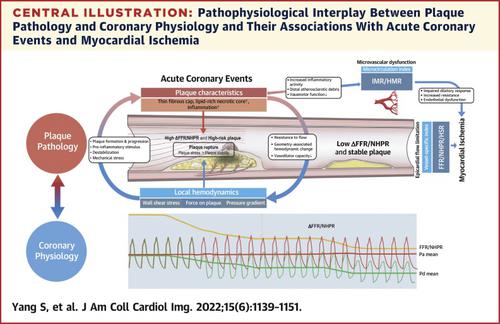JACC: Cardiovascular Imaging ( IF 12.8 ) Pub Date : 2021-12-15 , DOI: 10.1016/j.jcmg.2021.10.009 Seokhun Yang 1 , Bon-Kwon Koo 2 , Jagat Narula 3

|
High-risk coronary plaque refers to a distinct set of plaque characteristics prone to future coronary events. Coronary physiology represents a group of indexes reflective of the local physiological environment and hemodynamic changes in the macrovascular and microvascular system. Although a large body of evidence has supported the clinical relevance of these 2 factors, currently, identifying plaque morphology cannot reliably capture the lesion subset that causes hard events. Also, the guideline-directed approach based on physiological indexes cannot fully predict and prevent clinical events. In parallel, there is accumulating evidence that these 2 aspects of coronary artery disease influence each other with significant clinical implications, despite traditionally being considered to have separate effects on significances, treatments, and outcomes. In this state-of-the-art review, the authors explore the clinical evidence of pathophysiological interplay of physiological indexes related to local hemodynamics, epicardial stenosis, and microvascular dysfunction with plaque morphological characteristics that provide a better understanding of the nature of coronary events. Furthermore, the authors examine the emerging data on the complementary role between plaque morphology and coronary physiology in prognostication and how to apply this concept to overcome the limitations of individual assessment alone. Finally, they propose the potential benefit of integrative assessment of coronary anatomy, plaque quantity and quality, and physiological aspects of a target lesion and vessels for personalized risk profiling and optimized treatment strategy.
中文翻译:

形态学斑块特征与冠状动脉生理学之间的相互作用
高危冠状动脉斑块是指一组独特的斑块特征,易于发生未来的冠状动脉事件。冠状动脉生理学代表一组反映局部生理环境和大血管和微血管系统血流动力学变化的指标。尽管大量证据支持这两个因素的临床相关性,但目前,识别斑块形态不能可靠地捕获导致硬事件的病变子集。此外,基于生理指标的指南指导方法不能完全预测和预防临床事件。与此同时,越来越多的证据表明,冠状动脉疾病的这两个方面相互影响,具有重要的临床意义,尽管传统上被认为对意义、治疗和结果有不同的影响。在这篇最先进的综述中,作者探索了与局部血流动力学、心外膜狭窄和微血管功能障碍相关的生理指标与斑块形态学特征之间病理生理学相互作用的临床证据,从而更好地了解冠状动脉事件的性质。此外,作者研究了有关斑块形态和冠状动脉生理学在预测中的互补作用的新数据,以及如何应用这一概念来克服单独评估的局限性。最后,他们提出了综合评估冠状动脉解剖、斑块数量和质量以及目标病变和血管的生理方面的潜在益处,以进行个性化风险分析和优化治疗策略。作者探索了与局部血流动力学、心外膜狭窄和微血管功能障碍相关的生理指标与斑块形态学特征之间的病理生理相互作用的临床证据,从而更好地了解冠状动脉事件的性质。此外,作者研究了有关斑块形态和冠状动脉生理学在预测中的互补作用的新数据,以及如何应用这一概念来克服单独评估的局限性。最后,他们提出了综合评估冠状动脉解剖、斑块数量和质量以及目标病变和血管的生理方面的潜在益处,以进行个性化风险分析和优化治疗策略。作者探索了与局部血流动力学、心外膜狭窄和微血管功能障碍相关的生理指标与斑块形态学特征之间的病理生理相互作用的临床证据,从而更好地了解冠状动脉事件的性质。此外,作者研究了有关斑块形态和冠状动脉生理学在预测中的互补作用的新数据,以及如何应用这一概念来克服单独评估的局限性。最后,他们提出了综合评估冠状动脉解剖、斑块数量和质量以及目标病变和血管的生理方面的潜在益处,以进行个性化风险分析和优化治疗策略。











































 京公网安备 11010802027423号
京公网安备 11010802027423号